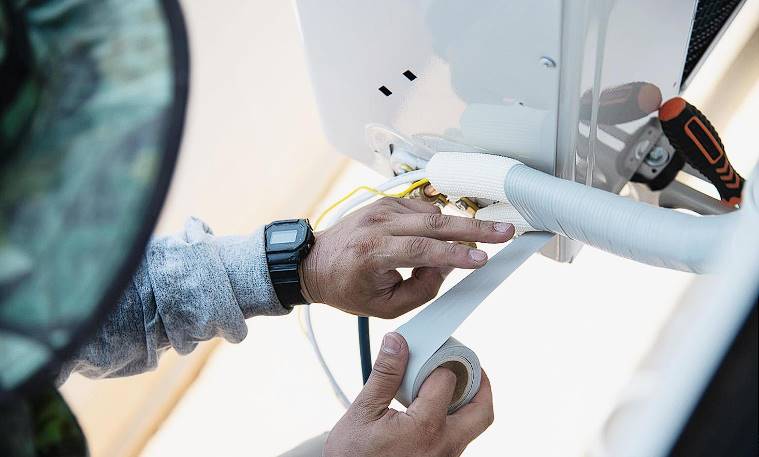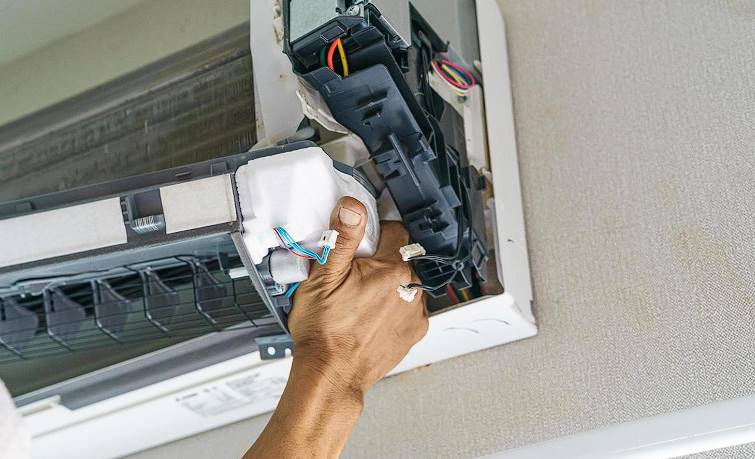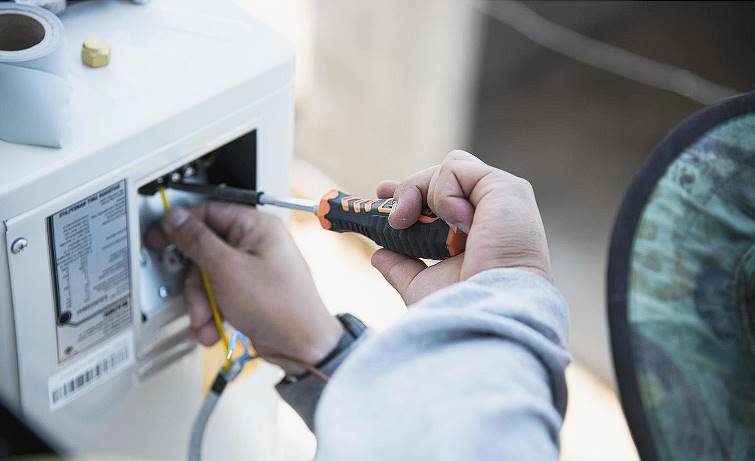If you need the correct thermostat (and if it isn't in the right spot), all of your efforts to maintain your HVAC system by cleaning it, replacing the air filter, and arranging regular tune-ups will be for naught.
Of all the varieties of thermostats available today, a smart thermostat is the one most typically suggested by HVAC specialists, and it may save you as much as $100 on your monthly energy bill.
A mechanical thermostat is no better than a simple on/off switch for your heating and cooling system; even the most basic programmed one is an improvement.
It would be best to consider your home's heating and cooling setup and your habits and preferences before buying a thermostat since you may not need or desire its advanced features.
Suppose you're the type of homeowner who likes to keep their hands on everything. In that case, you might be happier with a conventional programmed thermostat or even a mechanical one rather than one that requires you to communicate with it via a computer or mobile device.
What Is A Thermostat?
It would be best to have a reliable thermostat to keep your house at a consistent, pleasant temperature throughout the year. By keeping your heating and cooling systems operating at peak efficiency, thermostats are also important in reducing utility costs. Picking out the ideal thermostat for your house is a complex task.
It would be best to choose a thermostat that works with your home's heating and air conditioning system while providing you with the necessary conveniences (such as programmability, WiFi connectivity, smartphone control, self-learning capabilities, etc.).
How Do Smart Thermostats Work?
You undoubtedly know that thermostats keep track of the inside temperature and react to the heating and cooling schedules you set. How do they function, though? Essentially, a smart thermostat lets you adjust the temperature in your house and frequently other factors like humidity with any web-enabled device.
This implies that the homeowner may readily control house temperature using a mobile device or computer. This technology not only makes achieving interior comfort more quickly and easily, but it also has the potential to reduce costs and energy usage.
Advantages Of Smart Thermostat
Smart thermostats are a revolutionary improvement to domestic temperature regulation in today's era of rapid technological progress. This review digs into the various benefits of these smart gadgets, which eventually revolutionise how we interact with and control our home surroundings, from individualised comfort settings and energy savings to remote accessibility.
Learn how installing a smart thermostat may help you save money and energy while also improving the quality of your home life. Here are 5 benefits of installing a smart thermostat if you don’t already have one.
The Heating And Cooling Functions Of A Smart Thermostat Can Be Used At The Most Opportune Times.
You may program your smart thermostat to heat or cool the house just when people are there, and some models can even learn your typical routine. This eliminates the need to monitor the thermostat when you're gone from home.
Setting And Forgetting A Smart Thermostat Is A Breeze.
According to a poll, 89% of respondents rarely or never utilised their programmable thermostats to establish a workday or weekend schedule. If you don't use your thermostat's programmable setting, you might be paying to heat or cool your house when it's not essential.
Smart thermostats are incredibly easy to program, with most boasting digital touch displays that allow you to program the thermostat once and then forget about it. Adapting to your routine over time, 'smart' thermostats eliminate the need for programming while providing significant cost and time savings.
Keeping Tabs On Your Energy Use Is A Breeze With A Smart Thermostat.
Smart thermostats with WiFi connectivity give homeowners detailed real-time information about their energy use. With this information, you can generate a home energy profile that details seasonal variations in energy consumption and the impact on current and future energy bills. This information might help you change heating and cooling choices to cut energy expenses further.
Smart Thermostats Save Money And The Environment.
Easy to set and forget, programme, and alter remotely, smart thermostats give you a greater say over when and how long your HVAC system operates. With these features, you may save money on monthly energy bills by only using the HVAC system when it's absolutely necessary.
By installing a smart thermostat, you may save hundreds of dollars annually on your energy bills while still maintaining a comfortable environment in your home.
Smart Thermostats Are Easy To Install
A professional HVAC specialist will visit your home once you've purchased a smart thermostat and perform a quick installation. The HVAC expert will turn off the electricity and remove the old thermostat before installing the new one.
After that, they will install the new thermostat on your wall and link it to your home's electrical system. Finally, they will turn on the electricity and carry out the final steps of the programme. Once the system has been installed and programmed, the technician will give you a quick rundown on how to use it.
Steps To Select A Thermostat For Your Home
- Find out your home's cooling and heating setup.
- Pick from a thermostat of your liking.
- Choose the functions and customizations that are most useful for you.
Let's take a closer look at each of these measures.
Step 1: Let's Take A Closer Look At Each Of These Measures.
You can install a single-stage or multi-stage heating system.
Single Stage
Single-stage heating indicates that your furnace has just one level of heat production. Alternative methods of heating and air conditioning include a heat pump, gas furnace, or a distinct electric system. This, however, is the standard system used worldwide. If you install a thermostat, you may have as many as six wires protruding from the wall.
Multi-Stage
When your home has multi-stage heating, the temperature may be set at two levels. A solar panel or furnace would likely be part of your heating setup. The secondary heat setting is often reserved for use in an emergency.
Therefore, the multi-state unit runs for longer periods and provides more uniform heat distribution because the low setting is adequate to cover the heating or cooling needs of the home most of the time.
Heat Pump
This single system performs both heating and cooling of your house. Heat pumps can generate and distribute cool air; therefore, they are often used in place of dedicated AC units.
A heat pump is utilised as the emergency heat for multi-stage units. It can create heat significantly faster than any other unit and heat your house rapidly, even on cold days.
Multi-Stage Heat Pump
Like multi-stage systems, this one employs many components to provide heating and cooling; however, a heat pump is used for backup purposes. You'll still need a primary heating and cooling system, but the heat pump will make it possible to run that system more quickly and, in certain cases, more effectively.
Line Voltage
A line voltage system uses direct electric current instead of the 24 volts utilised by the standard thermostat in today's houses. Most homes that still utilise direct power have this type of thermostat. The power cables are often thicker and carry 120 or 240 volts of direct electricity.
These thermostats are frequently found in homes with older heating systems, such as baseboards or electric heaters. Since gas heaters are often single-stage systems, there is no need for these. The vast majority of thermostats for use with line power are mechanical.
The number of black and red wires in the device will vary from two to four depending on the thermostat's voltage and the home's wiring. So, have you identified your home's cooling and heating system? The next step is to decide the thermostat you want to install.
Step 2: Choose The Thermostat Type
Thermostats come in various forms, some of which are described here. Choose the kind you are searching for;
Learning Thermostat
The ability to set schedules for these contemporary thermostats is a great perk. The best thing is that they do not require any programming at all! As you use them, these devices gain knowledge and may tailor their schedules to your specific needs.
They can turn down automatically when you are away from home, assisting you in energy-efficient settings and presenting you with monthly energy reports. Plus, because they hook up to your Wi-Fi at home, you can control, adjust, and manage them from any smartphone, or tablet with an internet connection.
Remote Energy Management Thermostat
This thermostat allows you to manage your HVAC system remotely by tablet, smartphone, or computer. When linked to a home's internet network via a hub, this thermostat becomes accessible remotely over Wi-Fi.
Programmable Thermostat
The most effective way to reduce energy use and expenditures while also helping the planet is to install a programmable thermostat. It optimises energy use by maintaining a constant temperature throughout the house. Programme your prefered temperature settings for the day and night, and the thermostat will maintain that environment for you.
When selecting a programmable thermostat, consider how much leeway you'll need daily. Think about these four main choices:
- With 7-day scheduling, you may set up a new routine for each day of the week. This is ideal for households with many members with different daily routines.
- You may use the 5-2 method to plan your weekdays at work and your weekends at home according to two schedules.
- The 5-1-1 schedule allows you to select a regular weekday programme and two-weekend schedules. This is a terrific choice if your weekend plans are set in stone.
- 1 Week allows you to schedule a simple routine for a whole week.
Digital Non-Programmable Thermostat
If you'd rather manually adjust the temperature settings on your device, a digital non-programmable thermostat with a digital read-out is a great option, especially because it has the added benefit of an LCD that's simple to read.
Mechanical Or Manual Thermostats
The temperature may be adjusted manually using this thermostat. This is the best choice if you spend a lot of time at home and like to keep the temperature constant. Once you've decided on a specific category of thermostat, you can research specific models and customise their settings to your preferences.
Step 3: Choose The Functions And Extras That Suit Your Way Of Life
Before making your final decision, you'll need to consider what functions and aesthetics are most important to you. The following options are ones to think about:
- You may easily adjust the settings using the touchscreen controls.
- The backlit screen makes reading in low light or complete darkness easier.
- You may tailor the temperature settings for different time intervals inside the program.
- Lights that flash when the furnace's filter needs replacing or the battery needs replacing.
- Unwired and hardwired households can benefit from battery operation and backup in case of a power outage since this eliminates the need to adjust thermostats.
- Controls that may be set from a distance to improve ease and relaxation.
- Locking the keyboard protects the presets against tampering by children or others.
- Vacation mode lets you temporarily adjust your heating and cooling temps for optimal energy savings when you are away on vacation and return to regular settings when you are back, just with the push of a button.
If you consider the considerations mentioned earlier, you will choose the thermostat that is ideal for your needs.
Conclusion
Getting the right thermostat for your HVAC system is important if you want to keep your home at a comfortable temperature all year and save money on your energy bills.
Most HVAC professionals will tell you to get a smart thermostat, which can save you up to $100 a month on your energy bill. They do their job by keeping an eye on the temperature inside and responding to users' set heating and cooling plans.
Most smart thermostats have digital touch screens that let you set the temperature once and forget about it. This makes them easy to program. This gets rid of the need for writing and saves a lot of time and money.
When connected to WiFi, smart thermostats give you real-time information about how much energy you use. This lets you make a home energy profile that shows how your energy use changes with the seasons and how that will affect your present and future energy bills.
You can control when and for how long your HVAC system runs with a smart thermostat, which also saves money and the environment. You can save hundreds of dollars a year on your energy bills and keep your home comfortable by adding a smart thermostat.
When choosing a thermostat for your home, you should think about how your home cools and heats, pick a thermostat that you like, and pick the features and changes that you need. If you do these things, you can make sure that your HVAC system works well and that you save money on your monthly energy bill.
Before you install a heating system, you should think about what kind of system you want and how many wires will stick out of the wall. Multi-stage heating systems make heat on two levels, while single-stage systems only make heat on one.
Heat pumps can be used to cool or heat a building, and multi-stage heat pumps are used as a backup. People often find line voltage systems in older homes with older heating systems. These systems use direct electric power.
Learning thermostats, remote energy management thermostats, programmable thermostats, digital non-programmable thermostats, and mechanical or manual thermostats are some of the different types of thermostats.
Learning thermostats let people set times for them to work and control them from afar using Wi-Fi. Programmable thermostats keep the temperature in the whole house steady, which saves energy.
Before you buy a thermostat, you should think about how much flexibility you need each day. For example, you might need a 7-day, 5-2, 5-1-1, or 1-week schedule.
Digital heaters that don't need to be programmed have an easy-to-read digital display. With a mechanical or manual thermostat, the person can change the temperature settings by hand.
When making your final choice, you should think about both how it looks and how it works. Think about features like backlit screens, touchscreen controls, temperature settings that can be changed, flashing lights that let you know when furnace filters or batteries need to be replaced, battery operation and backup in case the power goes out, remote controls, keyboard lock protection, and holiday mode. You can pick the right thermostat for your home if you think about these things.
Content Summary
- Smart thermostats are recommended by HVAC experts for significant energy savings.
- A smart thermostat can save up to $100 monthly on energy bills.
- Mechanical thermostats are less efficient compared to programmable ones.
- ENERGY STAR awards signify high energy efficiency in smart thermostats.
- Newer smart thermostat models are increasingly responsive and user-friendly.
- Choosing a thermostat should be based on your home’s HVAC system and personal preferences.
- Homeowners who prefer manual control may opt for conventional programmable thermostats.
- Thermostats play a crucial role in maintaining consistent indoor temperatures year-round.
- The right thermostat can enhance the efficiency of heating and cooling systems.
- Thermostats are key to reducing utility costs through efficient energy use.
- Selecting a compatible thermostat for your home requires careful consideration.
- Smart thermostats can be controlled remotely via web-enabled devices.
- Smart thermostats offer convenience and potential energy and cost savings.
- Smart thermostats adapt to your routine, reducing the need for manual adjustments.
- Smart thermostats provide detailed real-time data on energy usage.
- Installing a smart thermostat can lead to significant savings on energy bills.
- Professional installation of smart thermostats ensures optimal functionality.
- Understanding your home's heating and cooling setup is vital for choosing a thermostat.
- There are various thermostat types, each suited to different heating systems.
- Single-stage heating systems are common and compatible with many thermostats.
- Multi-stage heating offers more levels of heat production for efficiency.
- Heat pumps are versatile, providing both heating and cooling.
- Multi-stage heat pumps offer efficient heating and cooling with backup options.
- Line voltage systems use direct electric current, often in older homes.
- Choosing a thermostat type depends on your home’s heating and cooling system.
- Learning thermostats adjust automatically to your routine and preferences.
- Remote energy management thermostats can be controlled from anywhere.
- Programmable thermostats optimize energy use and reduce costs.
- Digital non-programmable thermostats offer manual control with easy readability.
- Mechanical or manual thermostats are suitable for those who prefer constant temperature.
- Customizable settings allow you to tailor your thermostat to your lifestyle.
- Touchscreen controls on thermostats enhance user convenience.
- Backlit screens on thermostats facilitate reading in low light.
- Programmable thermostats allow for custom temperature settings throughout the day.
- Indicator lights on thermostats alert for filter changes or low battery.
- Battery operation in thermostats ensures functionality during power outages.
- Remote controls enhance the convenience of thermostat adjustments.
- Keyboard lock features prevent unintended changes to thermostat settings.
- Vacation mode in thermostats helps save energy when away from home.
- Smart thermostats offer monthly energy reports for better management.
- The 7-day scheduling feature in thermostats caters to varied daily routines.
- The 5-2 scheduling option is ideal for different weekday and weekend settings.
- The 5-1-1 schedule is perfect for regular weekdays and two separate weekend routines.
- A 1-week schedule in thermostats simplifies routine setting for the entire week.
- Considering functions and extras is crucial for a tailored thermostat experience.
- Thermostats with touchscreen controls are user-friendly and modern.
- Backlit displays in thermostats ensure readability in all lighting conditions.
- Customizable program intervals in thermostats provide flexibility.
- Flashing lights for maintenance alerts are a convenient feature in thermostats.
- Vacation mode in thermostats ensures energy efficiency when you're away.
Frequently Asked Questions
When selecting a thermostat for your air conditioning system, consider factors such as compatibility with your HVAC system, programming features, energy efficiency, and whether you prefer a wired or wireless model. Ensure the thermostat is compatible with your heating and cooling system to guarantee proper functionality.
Yes, smart thermostats are worth considering. They offer benefits like remote control via smartphone apps, learning algorithms to optimize energy usage, and the ability to create custom schedules. While they may have a higher upfront cost, the potential energy savings and convenience make them a valuable investment in the long run.
To ensure compatibility, check your HVAC system's specifications or consult with the manufacturer. Many thermostat manufacturers provide online compatibility tools where you can enter details about your system to verify if it works with the thermostat you're considering. Additionally, seeking advice from a professional HVAC technician is recommended.
Programmable thermostats offer the advantage of setting temperature schedules based on your routine. This helps optimize energy usage by adjusting temperatures when you're away or asleep. The ability to create customized programs ensures your home is comfortable when needed while saving on energy costs during periods of lower activity.
The complexity of thermostat installation varies. While some models are user-friendly and come with detailed instructions, others may require professional installation. If you're uncertain or uncomfortable working with electrical components, it's advisable to hire a licensed HVAC technician to ensure the thermostat is installed correctly and functions properly.



